| Author |
 Topic Topic  |
|
uthminsta
1000+ Penny Miser Member
    
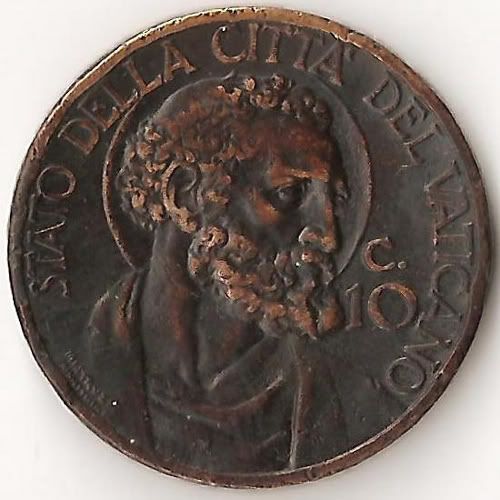
USA
1872 Posts |
Posted - 12/30/2009 : 09:26:04


|
Yikes, what is that? :)
EDIT: Cool. Very cool. |
Come to the new and improved realcent: http://realcent.org
|
Edited by - uthminsta on 12/30/2009 10:18:35 |
 |
|
|
jtm3
Penny Pincher Member
 

USA
187 Posts |
 Posted - 12/30/2009 : 10:18:17 Posted - 12/30/2009 : 10:18:17


|
quote:
Originally posted by Country
Here's a Roman bronze that has a lot of history. This coin doesn't look like much, but looks are deceiving sometimes. It is a Sesterus half dollar sized coin) that was minted in Antioch showing the first Roman Emperor Augustus on the obverse and the Roman SC on the reverse.

I can't imagine what that coin has gone through! |
Copper Cent Hoarding Wiki
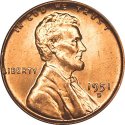
coppercenthoarding.wikia.com
+637 posts |
Edited by - jtm3 on 12/30/2009 10:25:13 |
 |
|
|
uthminsta
1000+ Penny Miser Member
    

USA
1872 Posts |
 Posted - 12/30/2009 : 17:33:52 Posted - 12/30/2009 : 17:33:52


|
Barbados cent. Bronze from 1973-1991, then copper-plated zinc.
 
This is my wife's. She collects coins depicting beach scenes, and this one kind of loosely fits that because of the fish and pelican. I personally like it cause of the trident. 
Tomorrow's entry will be a fun one, and then starting January 1st, I have a "series" to show off.  |
Come to the new and improved realcent: http://realcent.org
|
 |
|
|
uthminsta
1000+ Penny Miser Member
    

USA
1872 Posts |
 Posted - 12/31/2009 : 13:02:06 Posted - 12/31/2009 : 13:02:06


|
Marta token!
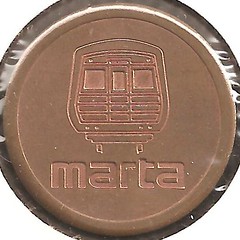 
MARTA stands for Metropolitan Atlanta Rapid Transit Authority. They used tokens until 2006, when they got the "Breeze card." I think this was the final type of token, and there were smaller ones used earlier on.
I have not been able to find the composition of this coin. I am assuming it is primarily copper, and not copper-plated-anything. Anyone know more?
Have a happy new year everyone. |
Come to the new and improved realcent: http://realcent.org
|
 |
|
|
uthminsta
1000+ Penny Miser Member
    

USA
1872 Posts |
 Posted - 01/01/2010 : 17:16:47 Posted - 01/01/2010 : 17:16:47


|
Introducing the Great Britain series!
Day 1: GEORGE I. King from 1714-1727.


No penny yet! Pennies were a very small silver coin until the introduction of the cartwheel penny in 1797. In fact, the last circulation silver penny was made in 1820. |
Come to the new and improved realcent: http://realcent.org
|
Edited by - uthminsta on 01/12/2010 16:52:59 |
 |
|
|
HoardCopperByTheTon
Administrator
    

USA
6807 Posts |
Posted - 01/01/2010 : 19:08:55


|
| That Sestertius is a very cool coin Country! I think the SC has something to do with Senatorial Council or something like that. Augustus prevailed against the forces of Marc Anthony and Cleopatra. According to accounts I have read, she was not nearly as cute as the lady that portayed her in the Hollywood version. |
If your percentages are low.. just sort more. If your percentages are high.. just sort more.
Now selling Copper pennies. 1.6x plus shipping. Limited amounts available. |
 |
|
|
Country
1000+ Penny Miser Member
    

USA
3121 Posts |
 Posted - 01/01/2010 : 20:06:52 Posted - 01/01/2010 : 20:06:52


|
quote:
Originally posted by Country
Here's a Roman bronze that has a lot of history...
The "SC" on the reverse of this coin: Senatus Consulto - by decree of the Roman Senate. This appeared on most of the Roman bronze coins of the Imperial period. The Senate became a consulting body of legislators wth little real power. However, the Imperial period was ruled by its Emperors.
|
---> Come to the new and improved realcent: http://realcent.org
The things that will destroy America are prosperity-at-any-price, peace-at-any-price, safety-first instead of duty-first, the love of soft living, and the get-rich-quick theory of life.
– Theodore Roosevelt
|
 |
|
|
Country
1000+ Penny Miser Member
    

USA
3121 Posts |
 Posted - 01/01/2010 : 20:27:14 Posted - 01/01/2010 : 20:27:14


|
Here's a nice Russian bronze 5 Kopek minted during the reign of Catherine the Great. This hefty coin weighs in at 51.35g and is 1/8 inches (1/2 cm) thick. The Russians used large coppers as currency; SILVER and GOLD was only available to the rich elites.
This coin is in great condition and has traces of mint luster. The "E M" mintmark indicates the Ekaterinburg mint. Also, are portrayed the letter E, the first letter in Ekaterina (Russian for Catherine) between the 17 and 71 of the date. Notice the Romanov double-eagle on the other side of the coin.

 |
---> Come to the new and improved realcent: http://realcent.org
The things that will destroy America are prosperity-at-any-price, peace-at-any-price, safety-first instead of duty-first, the love of soft living, and the get-rich-quick theory of life.
– Theodore Roosevelt
|
Edited by - Country on 01/01/2010 20:52:41 |
 |
|
|
HoardCopperByTheTon
Administrator
    

USA
6807 Posts |
Posted - 01/01/2010 : 20:29:07


|
That is a seriously cool looking coin too. Is that a Russian 5 Kopek?  |
If your percentages are low.. just sort more. If your percentages are high.. just sort more.
Now selling Copper pennies. 1.6x plus shipping. Limited amounts available. |
 |
|
|
jtm3
Penny Pincher Member
 

USA
187 Posts |
 Posted - 01/01/2010 : 20:43:35 Posted - 01/01/2010 : 20:43:35


|

1773 Virginia Half-penny
Minted in England solely for the American colonies.
Obverse: King George III
Reverse: Shield of Virginia
Feel free to add more information! |
Copper Cent Hoarding Wiki

coppercenthoarding.wikia.com
+637 posts |
Edited by - jtm3 on 01/01/2010 20:44:19 |
 |
|
|
uthminsta
1000+ Penny Miser Member
    

USA
1872 Posts |
 Posted - 01/01/2010 : 20:48:27 Posted - 01/01/2010 : 20:48:27


|
quote:
Originally posted by jtm3Feel free to add more information!
- Wanted by uthminsta. |
Come to the new and improved realcent: http://realcent.org
|
 |
|
|
HoardCopperByTheTon
Administrator
    

USA
6807 Posts |
Posted - 01/01/2010 : 20:51:01


|
- Wanted by HCBTT also  |
If your percentages are low.. just sort more. If your percentages are high.. just sort more.
Now selling Copper pennies. 1.6x plus shipping. Limited amounts available. |
 |
|
|
uthminsta
1000+ Penny Miser Member
    

USA
1872 Posts |
 Posted - 01/01/2010 : 20:57:44 Posted - 01/01/2010 : 20:57:44


|
| woohoo, 1000 views! |
Come to the new and improved realcent: http://realcent.org
|
 |
|
|
wolvesdad
1000+ Penny Miser Member
    

USA
2164 Posts |
Posted - 01/01/2010 : 21:04:02


|
I would love an early American coin that still had good design features visible and wasn't corroded to all retardation.
Nice one indeed. |
"May your percentages ever increase!" |
 |
|
|
Country
1000+ Penny Miser Member
    

USA
3121 Posts |
 Posted - 01/01/2010 : 21:14:44 Posted - 01/01/2010 : 21:14:44


|
quote:
Originally posted by jtm3

1773 Virginia Half-penny
Minted in England solely for the American colonies.
Obverse: King George III
Reverse: Shield of Virginia
Feel free to add more information!
As a Virginian, this was one of the first coins I had to buy for my early coppers. I really like this coin!!
Here's a little history of the 1773 Virginia Half Pence:
The Virginia Halfpenny of 1773: Introduction
Although the April 10, 1609 charter for the Virginia Plantation included the authority to mint coins the colony did not choose to exercise this privilege until May 20, 1773, when the Virginia Assembly authorized the coining of a halfpenny at the Tower mint in London. The coin, engraved by Richard Yeo, was made of copper at a weight of sixty halfpence to the pound. Five tons of halfpence (about 670,000 pieces) arrived in New York aboard the ship "Virginia" on February 14, 1774 but were not distributed until written royal permission was obtained about a year later. The Virginia treasurer, Robert Nicholas, published a notice bearing the date February 27, 1775 in all issues of the Virginia Gazette printed between March 2-16, explaining that "copper money is now ready to be issued in Exchange either for Gold, Silver or any Treasury Notes." Soon after the initial disbursement of the coins commenced, the Revolutionary war broke out in Massachusetts at Lexington and Concord on April 19, 1775. Consequently Virginians hoarded the new halfpenny, along with all other copper coins, until the end of the war. Although the halfpenny contained the portrait of the king of England, it is clear these coins were used in Revolutionary and post war Virginia, for out of fifty-nine coins found during the restoration of Colonial Williamsburg, forty were Virginia halfpence.
At some point during the Nineteenth century, Colonel Medes Cohen (1796-1879) of Baltimore acquired a large quantity of uncirculated specimens which he slowly sold off over a period of years. In 1952 Breen suggested Cohen found the halfpence in a government office in Annapolis then, later, in his Encyclopedia Breen stated Cohen had found a keg of the coins in Richmond sometime after the Civil War. In fact, nothing is known as to the quantity, location or date of the acquisition of these coins. We do know that in 1929 his descendants auctioned off all that remained of the find, some 2,200 coins. Several were in red mint condition but were either spotted or stained. Many of the halfpence were acquired by the dealer Waite Raymond and later resold. For additional information see the discussion by Q. David Bowers (who suspects the hoard was found in the 1870's) in his work cited below on coin hoards.
The halfpenny displays the bust of George III on the obverse with the shield of Virginia on the reverse. There are several variants listed by Newman. He lists 13 obverse varieties with no stop after GEORGIVS (1-13) and 9 obverses with a stop (15 and 20-27). Two reverses have a harp with six strings (A-B), 15 varieties have seven harp strings (D-T, with no variety assigned to the letters I or L) and 5 varieties with eight harp strings (V Z). These 22 obverses and 22 reverses are found in 28 different combinations. There is also a nine harp strings reverse die that survives in the royal mint collection but does not appear to have been used for production as no examples have been found with that reverse. There is also a very rare larger size proof prototype, sometimes referred to as a "penny," and an extremely rare silver proof pattern dated 1774 that was engraved by Thomas Pingo, often referred to as a "shilling". Breen knew of six examples of this latter variety. The matrixes and device punches for the halfpenny still exist in the Royal Mint collection in London.
You must be logged in to see this link. |
---> Come to the new and improved realcent: http://realcent.org
The things that will destroy America are prosperity-at-any-price, peace-at-any-price, safety-first instead of duty-first, the love of soft living, and the get-rich-quick theory of life.
– Theodore Roosevelt
|
Edited by - Country on 01/01/2010 21:32:37 |
 |
|
|
uthminsta
1000+ Penny Miser Member
    

USA
1872 Posts |
 Posted - 01/02/2010 : 22:58:20 Posted - 01/02/2010 : 22:58:20


|
Great Britain series, day 2:
GEORGE II. King from 1727-1760.
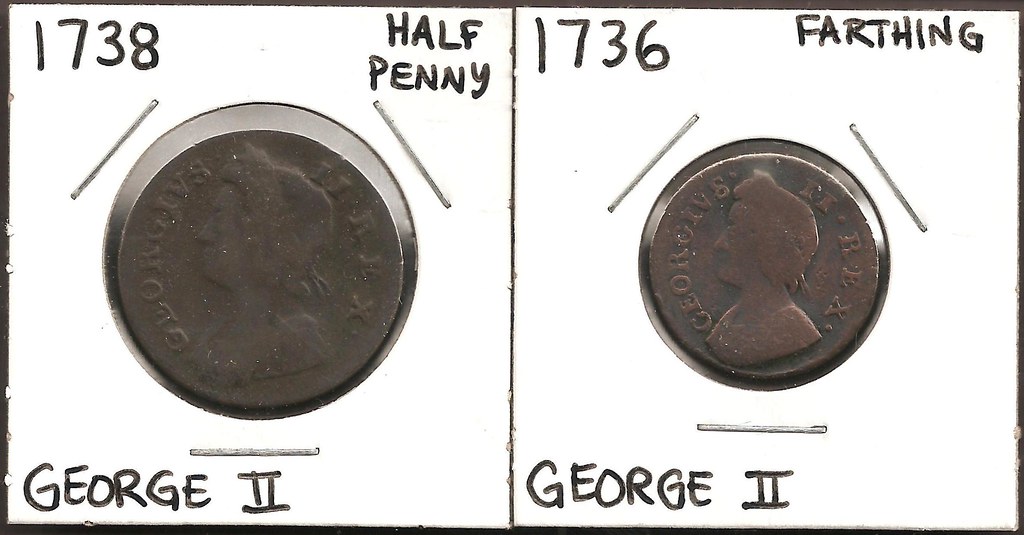

I'll try to put at least one fact here each day... Copper farthings were introduced in 1672. Silver hammered farthings were used at least as far back as the 1200's. Edward I (1272-1307) farthings were produced in rather large quantities. Previously, the need for smaller denominations had been met by cutting pennies into halves or quarters. A Henry III (1216-1272) farthing has been discovered relatively recently, resulting from improvements to metal detectors. It may be a trial issue... |
Come to the new and improved realcent: http://realcent.org
|
Edited by - uthminsta on 01/12/2010 16:51:20 |
 |
|
|
uthminsta
1000+ Penny Miser Member
    

USA
1872 Posts |
 Posted - 01/04/2010 : 09:06:55 Posted - 01/04/2010 : 09:06:55


|
Great Britain series, day 3:
GEORGE III. King from 1760-1820.
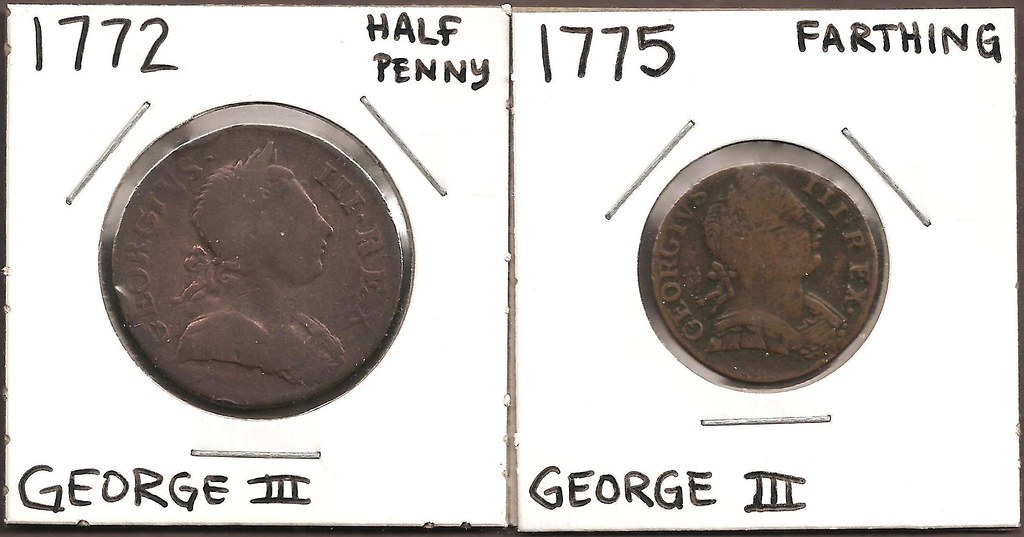
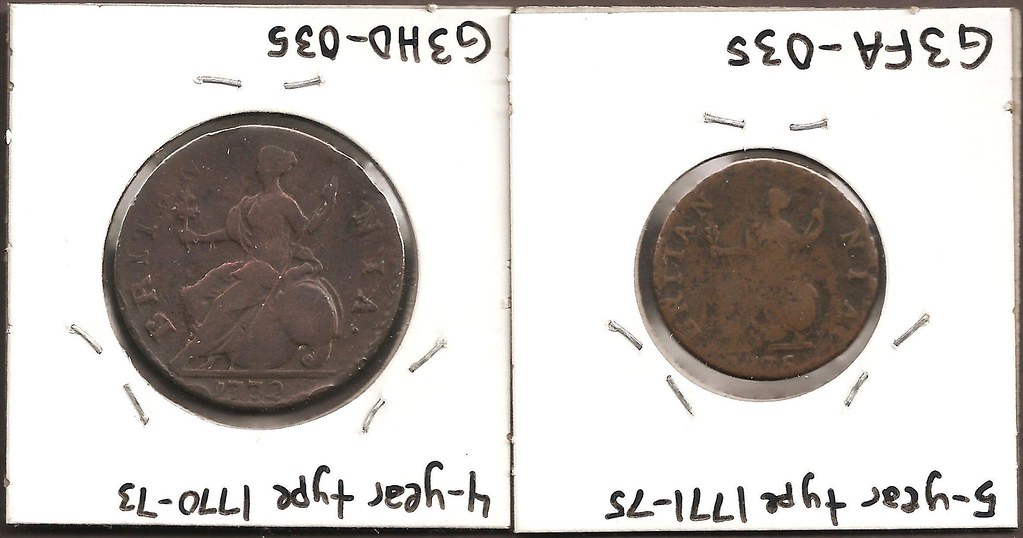
This is the first of three main mintings/designs of the George III reign. These coins were produced from 1770-1775 only - up until the revolutionary war. There would be a gap of over 20 years before copper coins were minted again. This design was very widely counterfeited in England AND in the colonies.
Copper halfpennies were introduced in 1672 (Charles II, 1660-1685), when coins were first milled instead of hammered. Silver hammered halfpennies were used as far back as the early 1100's (HenryI, 1100-1135), but existing copies are still exceedingly rare; same with Henry III (1216-1272). Edward I (1272-1307) halfpennies were produced in larger quantities, as this reign marked an increase in all smaller coinage. |
Come to the new and improved realcent: http://realcent.org
|
Edited by - uthminsta on 01/12/2010 16:49:34 |
 |
|
|
uthminsta
1000+ Penny Miser Member
    

USA
1872 Posts |
 Posted - 01/05/2010 : 19:52:03 Posted - 01/05/2010 : 19:52:03


|
Great Britain series, day 4:
GEORGE III. King from 1760-1820.


The "cartwheels" are the SECOND design of the George III reign, and in my opinion, one of the most interesting. In the 1770's and following, counterfeits/forgeries were rampant in England - in fact, it was believed that the majority of circulating copper coins were counterfeit. Step one: in 1771, counterfeiting became a felony - 'in March 1782, a woman convicted of counterfeiting was hanged, then fixed to a stake and burnt before the debtor's door at Newgate prison.'
Step two: In comes Matthew Boulton, who changed everything... "In a proclamation dated 26 July 1797, it was declared that 'certain pieces of copper should be coined, which should go and pass for one Penny and two Pennies, and that each of such pieces of one Penny should weigh one ounce Avoirdupois and that each such two Penny pieces should weigh two ounces Avoirdupois; the intrinsic value of such pieces of 1 Penny and 2 Pennies, workmanship included, corresponding as nearly as possible with the nominal value of the same respectively.'" So he was granted a contract in 1797 to produce twopence and pennies, and 1798/1799 to produce halfpennies and farthings. It was believed that he would be overwhelmed if asked to produce all four denominations in sufficient amounts all at once.
It goes on to say that 'much of this coinage was melted down around 1800 when the price of copper increased. By 1805, the intrinsic value of the metal exceeded the face value by about 30%."
These coins were each a one-year type... well, sort of. The twopence and penny (coins one and two above) were all dated 1797. The halfpenny (coin 3) and farthing (not shown) were all dated 1799. But these coins were minted for several years with the same date. There are as many as a hundred variations in the penny, mostly dealing with the boat next to Britannia. These variations were likely die identification marks.
Above quotes are compiled from several entries in Coincraft's Standard Catalogue of English & UK Coins 1066-Date. |
Come to the new and improved realcent: http://realcent.org
|
Edited by - uthminsta on 01/12/2010 16:48:06 |
 |
|
|
uthminsta
1000+ Penny Miser Member
    

USA
1872 Posts |
 Posted - 01/06/2010 : 17:42:35 Posted - 01/06/2010 : 17:42:35


|
Great Britain series, day 5:
GEORGE III. King from 1760-1820.
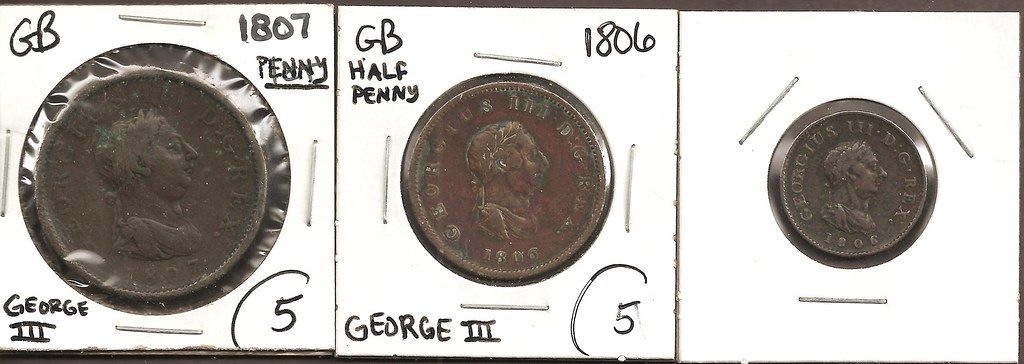
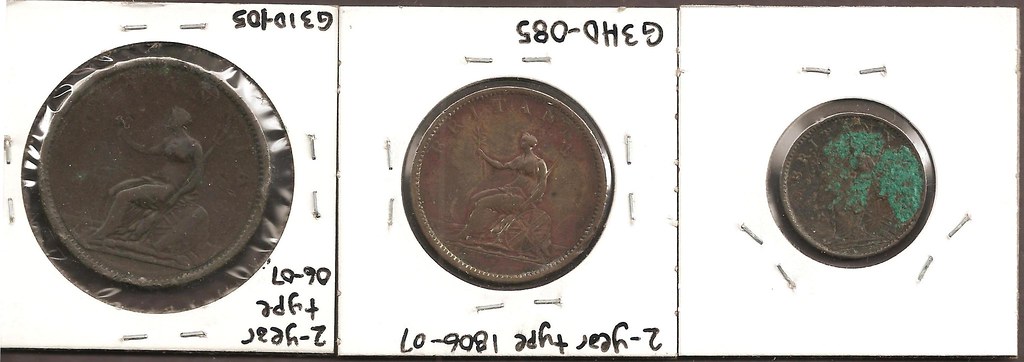
This is the THIRD design of the George III reign.
From yesterday: There was a big problem in the late 18th century of counterfeiting, so England made coins that couldn't easily be counterfeited. They were big and heavy. And by 1805, the intrinsic value of the metal (in the cartwheel twopence and pennies) exceeded the face value by about 30%. So along comes the coinage of 1806-1807, shown above. The "innovative" cartwheel design was abandoned and the metal content was reduced. Total metal used: 150 tons of copper for the pennies, 427.5 tons for the halfpennies, 22.5 tons for the farthings.
Tomorrow: everything I can find out about the "Great Recoinage" of 1816. |
Come to the new and improved realcent: http://realcent.org
|
Edited by - uthminsta on 01/12/2010 16:44:39 |
 |
|
|
uthminsta
1000+ Penny Miser Member
    

USA
1872 Posts |
 Posted - 01/07/2010 : 19:03:23 Posted - 01/07/2010 : 19:03:23


|
Great Britain series, day 6:
GEORGE IV. King from 1820-1830.


The Great Recoinage of 1816 primarily restructured the "top end" of the denominations in British coinage. The gold Guinea of 21 shillings, as well as the half/third/fourth guinea pieces, were abandoned for the Sovereign of 20 shillings and the more easily divided gold half sovereign (ten shillings) and silver crown (five shillings).
Gold and silver coinage took precedence, so production of copper coinage was not resumed until 1821, beginning with the farthing. The halfpenny and penny were not produced until 1825-26.
So here's George IV. Pictured are the penny, halfpenny, and farthing. Also issued were the half farthing and third farthing, although these were primarily for use in Ceylon (half) and Malta (third). These were the first British coins of such small denomination. Pretty tiny copper, but not the smallest.  |
Come to the new and improved realcent: http://realcent.org
|
Edited by - uthminsta on 01/12/2010 16:31:29 |
 |
|
|
aloneibreak
Penny Hoarding Member
   

USA
672 Posts |
Posted - 01/07/2010 : 19:09:06


|
im enjoying reading these posts uthminsta !
ive got a couple of the george III coins but mine are in terrible shape. its nice to see pics of what they should look like. |
My reading of history convinces me that most bad government results from too much government.
Thomas Jefferson
|
 |
|
|
uthminsta
1000+ Penny Miser Member
    

USA
1872 Posts |
 Posted - 01/08/2010 : 13:05:30 Posted - 01/08/2010 : 13:05:30


|
Great Britain series, day 7:
WILLIAM IV. King from 1830-1837.
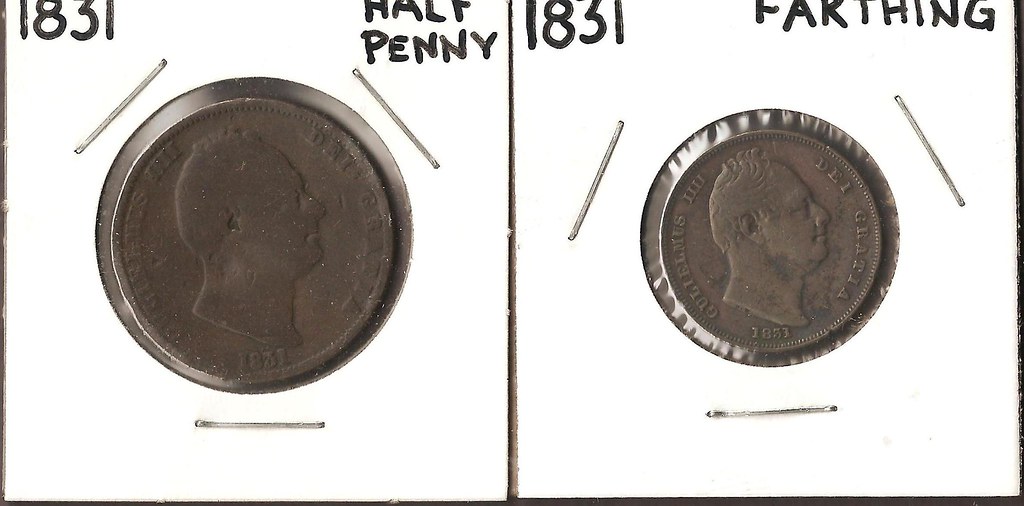
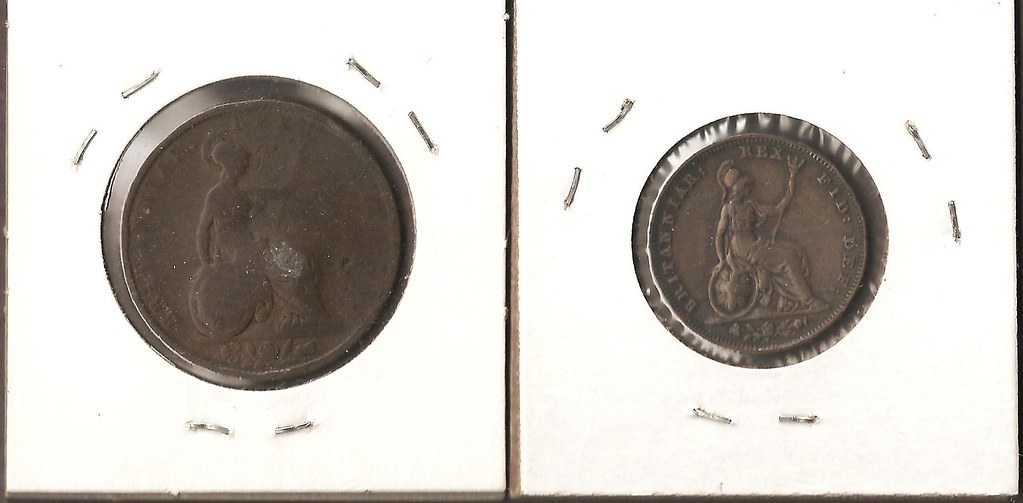
These facts have primarily dealt with the coins, but today I thought it might be fun to look at the subject depicted. William IV was the younger brother of George IV, third son of George III. Coolest thing about him was that he abolished slavery throughout most of the British Empire. To learn more, check out You must be logged in to see this link.
Copper coinage of William IV includes the penny, HALFPENNY, FARTHING, 1837 half farthing (scarce) and 1835 third farthing.
Again, the third farthing was issued for use in Malta, and the half farthing was for use in Ceylon. It is scarce because shortly after production was begun, William died (June 1837). |
Come to the new and improved realcent: http://realcent.org
|
Edited by - uthminsta on 01/12/2010 16:46:22 |
 |
|
|
uthminsta
1000+ Penny Miser Member
    

USA
1872 Posts |
Posted - 01/10/2010 : 08:21:23


|
| Limited access to internet yesterday, today, and tomorrow. But since this thread is my baby, I wanted to post here. I will post again on Tuesday, beginning the VICTORIA years. In the meantime, cmon everyone, where's your beautiful bronze? |
Come to the new and improved realcent: http://realcent.org
|
 |
|
|
uthminsta
1000+ Penny Miser Member
    

USA
1872 Posts |
 Posted - 01/12/2010 : 16:28:20 Posted - 01/12/2010 : 16:28:20


|
Great Britain series, day 8:
VICTORIA. Queen from 1837-1901 - the longest reigning monarch!


This is the first of four major designs for Victoria, and the last of the true copper issues; in 1860, the coins were reduced in size, and changed from pure copper to bronze (95% copper, 4% tin, 1% zinc).
Shown are the penny (18.8g, 34mm); halfpenny (9.1-9.5g, 28mm); farthing (4.5-4.9g, 22mm); and half farthing (2.4g, 18mm, initially for use in Ceylon only). Not shown are the third farthing (issued for use in Malta, minted in 1844 only, 1.5-1.6g, 16mm) and quarter farthing (issued for use in Ceylon, 1.2g, 13.5mm).
The quarter farthing has the distinction of being the lowest denominated coin in Britain's long history. It, along with the third farthing, were never accepted as legal tender in Britain, but the half farthing was, beginning in 1842. |
Come to the new and improved realcent: http://realcent.org
|
Edited by - uthminsta on 01/12/2010 22:32:06 |
 |
|
|
uthminsta
1000+ Penny Miser Member
    

USA
1872 Posts |
 Posted - 01/13/2010 : 23:26:29 Posted - 01/13/2010 : 23:26:29


|
Great Britain series, day 9:
VICTORIA, young head bronze. Minted from 1860-1894, and some 1895 farthings.


This is the second design for Victoria, beginning the "bronze era." Copper coins had been minted from 1797 until 1860; now bronze coins would be used from 1860 until 1992.
Shown are the penny (9.4g, 31mm); halfpenny (5.5-5.8g, 28mm); farthing (2.8-3g, 20mm); and third farthing (0.9-1.0g, 15mm, again for use in Malta only). Not shown are the half and quarter farthing, both minted in 1868 as proofs only. That was the last of the half and quarter farthings. Third farthings stuck around for a couple more monarchs...
On a personal note, Victorian pennies were the first British coins I ever bought, back in the summer of 1998. That is what started this whole collection! |
Come to the new and improved realcent: http://realcent.org
|
 |
|
 Topic Topic  |
|


